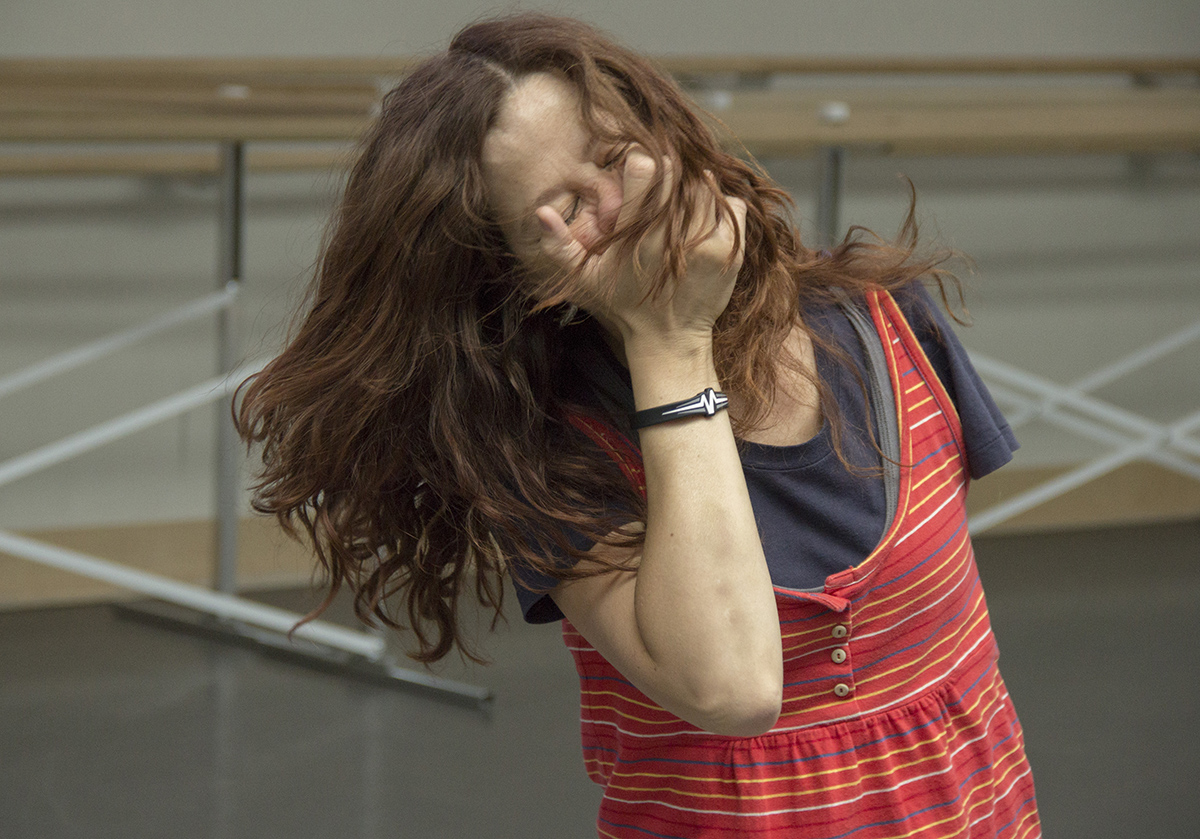‘Impasse’ challenges traditional views on disabilities

“Impasse” is a dance solo performance by Catherine Long and a reconstruction of “Stalemate,” a 2009 solo performed by UCLA world arts and cultures doctoral student Doran George. Long’s 30-minute dance performance will be followed by a discussion with Long and George about the discourse surrounding dance and disability.
(Angie Wang/Daily Bruin senior staff)
By Natalie Chudnovsky
April 28, 2014 12:33 a.m.
Catherine Long lies onstage, arm outstretched, laughing repeatedly.
The audience may question what it’s seeing. It may be forced to analyze how it approaches a body of difference. It may reconsider its definition of dance. As the laughter continues, it may become uncomfortable – and that’s a good thing.
“Impasse” is a dance solo performed by Long, a disabled dancer from London. Long considers herself being disabled “by social constructions, attitudes and environments, rather than the structure of (her) body disabling (her).”
The dance is a reconstruction of “Stalemate,” a 2009 solo choreographed and performed by UCLA world arts and cultures doctoral student Doran George. The 30–minute multimedia performance, in which Long dances against a projection by filmmaker Barry Shils, will be followed by a discussion by Long and George about marginalized bodies in culture and dance.
Long performs to the soundscape of the film – a conversation held in a car ride. She uses truncated and absurd movements to purposefully counter the elegance-focused aesthetics of contemporary dance.
“It’s a minimalist dance,” George said. “It uses repetition to amplify mundane movement or movement that seems awkward or disturbing.”
Long traveled from London to work with George on refashioning the dance for her physical structure. “Impasse” draws on the themes in “Stalemate” about embodying varying states of emotion and pushes them to explore the way disability is perceived.
“There’s a part where I stand and shake my hand really fast and wiggle from side to side 89 times. I keep my face very deadpan,” she said. “I feel very self-conscious showing my vulnerability and highlighting movements that are ridiculous. But there’s something fantastic in that I’m not trying to fulfill someone else’s ideal or my own.”
Long and George met each other in 2008. Long, who was an artist-in-residence at the Institute of Cognitive Neuroscience in London, was working on a project about pain and disability. She began a collaboration with George, who eventually approached her about working on “Impasse.”
George said “Stalemate” was a physically and emotionally difficult piece and was hesitant to ask Long to do the jarring performance.
“I said to her, ‘I think it would be amazing if you did this dance, but I can’t ever imagine asking you,'” George said.
From 2008 to 2011, Long founded and danced in Heidi Latsky’s “GIMP,” a performance by Latsky’s integrated dance company, which features dancers who have disabilities. She was also taking contemporary dance classes and said her experiences with both made her frustrated. She was looking for a solo that would strengthen her body and allow her to explore the way bodies of difference interact with other people.
Long said she was interested in creating a piece where she wasn’t trying to be graceful or conform to contemporary dance notions of beauty.
“A lot of mixed-ability dance involves bodies that are signified as other – particularly disabled – making them fit into a social construction of what’s elegant,” Long said. “But I felt there was something missing that needed to be addressed.”
This is why, despite the daunting nature of “Stalemate,” Long said she jumped at the chance to work with George and reconstruct the piece.
Although George and Long said they don’t want to diminish the work done by integrated dance companies, they want to push past the cultural myth that describes bodies that are disabled as either helpless or superhuman in the way they overcome disability.
“We wanted to open up space where the difficulties of living with (disabilities) get to be on stage,” George said.
George said the costume, created by designer and Fashion Institute of Design and Merchandising faculty member Anne-Marie Allen, plays a large role in negotiating the ways Long’s body is perceived by the audience.
Long wears shiny grey trousers and a top with fringing and a hood. Allen said the piece gives Long the agency to alternately reveal and conceal herself while the fabric amplifies her movements.
“The costume is like a flower that’s closed up in the beginning, and by the end, it opens up,” Allen said.
George said another theme in “Impasse” is the way loss is projected onto bodies of difference.
“People often say, ‘What happened to you? Did you have an accident?'” Long said. “They automatically see what they perceive as an absence before they engage in what’s actually present.”
The piece is transformed simply by having Long perform it because of the way her body signifies within culture, George said.
Long said she was captivated by George’s performance in “Stalemate.” However, “Impasse” is not an emulation or representation, but a completely new piece.
“Doran really put himself on the line. Going from state to state, the intensity, the all-out commitment – I absolutely loved it, but it made me feel sick,” Long said. “But that’s what I want to do as a performer: to move people in that way.”


